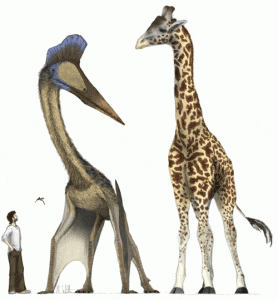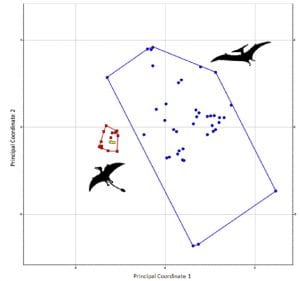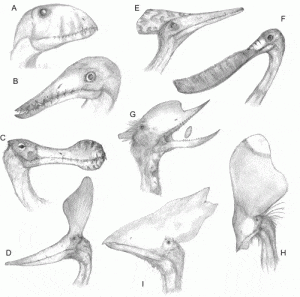The rise and rise of the flying reptiles
Pterosaurs, flying reptiles from the time of the dinosaurs, were not driven to extinction by the birds, but in fact they continued to diversify and innovate for millions of years afterwards. A new study by Katy Prentice, done as part of her undergraduate degree (MSci in Palaeontology and Evolution) at the University of Bristol, shows that the pterosaurs evolved in a most unusual way, becoming more and more specialised through their 160 million years on Earth.
 Figure 1 (left). Extremes in pterosaur morphology. The giant and probably flightless Quetzalcoatlus from the Late Cretaceous of Texas was as tall as a giraffe. The small insectivorous Anurognathus from the Late Jurassic of Germany is seen flying above the artist’s head. Drawings by Mark Witton.
Figure 1 (left). Extremes in pterosaur morphology. The giant and probably flightless Quetzalcoatlus from the Late Cretaceous of Texas was as tall as a giraffe. The small insectivorous Anurognathus from the Late Jurassic of Germany is seen flying above the artist’s head. Drawings by Mark Witton.
‘Usually, when a new group of animals or plants evolves, they quickly try out all the options. When we did this study, we thought pterosaurs would be the same,’ said Katy. ‘Pterosaurs were the first flying animals – they appeared on Earth 50 million years before Archaeopteryx, the first bird – and they were good at what they did. But the amazing thing is that they didn’t really begin to evolve until after the birds had appeared.’
Katy’s study was done in conjunction with her supervisors, Dr Marcello Ruta and Professor Michael Benton. They looked at 50 different pterosaurs that ranged in size from a blackbird to the largest of all, Quetzalcoatlus, with a wingspan of 12 metres, four times the size of the largest flying bird today, the albatross. They tracked how all the pterosaur groups came and went through their history and recorded in detail their body shapes and adaptations.
 Figure 2 (right). Chart showing the morphospace for all 53 pterosaur species included in this study, based on principal coordinates 1 and 2. Red squares are the basal rhamphorhynchoids, blue circles the derived pterodactyloids; the yellow squares are two possible ancestors of pterosaurs, included for comparison. The two suborders have significantly different morphospaces in terms of size, and the spread of taxa: the range of morphologies shown by the late Jurassic to Cretaceous pterodactyloids is about twenty times the area occupied by late Triassic and Jurassic rhamphorhynchoids, corresponding to the relative morphological diversity in both groups. Note also how the primitive rhamphorhynchoids are closely associated with the putative ancestors. The two suborders do not overlap in morphospace.
Figure 2 (right). Chart showing the morphospace for all 53 pterosaur species included in this study, based on principal coordinates 1 and 2. Red squares are the basal rhamphorhynchoids, blue circles the derived pterodactyloids; the yellow squares are two possible ancestors of pterosaurs, included for comparison. The two suborders have significantly different morphospaces in terms of size, and the spread of taxa: the range of morphologies shown by the late Jurassic to Cretaceous pterodactyloids is about twenty times the area occupied by late Triassic and Jurassic rhamphorhynchoids, corresponding to the relative morphological diversity in both groups. Note also how the primitive rhamphorhynchoids are closely associated with the putative ancestors. The two suborders do not overlap in morphospace.
The new work (Fig. 2) shows that pterosaurs remained conservative for 70 million years, and then started to experiment with all kinds of new modes of life. After birds emerged and became successful, the pterosaurs were not pushed to extinction, as had been suggested. It seems they responded to the new flyers by becoming larger and trying out new lifestyles. Many of the new lifestyle adaptations were seen in the pterosaurs skulls, as they adapted to feed on different food sources; some were seed-eaters, many ate fish, and later ones even lost their teeth. The rest of the body also showed a surprising amount of variation between different groups, when considering that the body forms have to retain many features to allow flight.
‘Pterosaurs were at the height of their success about 125 million years ago, just as the birds became really diverse too,’ said Dr Marcello Ruta. ‘Our new numerical studies of all their physical features show they became three times as diverse in adaptations in the Early Cretaceous than they had been in the Jurassic, before Archaeopteryx and the birds appeared.’
Pterodactyloid disparity: head crests
The remarkable difference betwen rhamphorhynchoid and pterodactyloid morphospace occupancy (Fig. 2) is reflected in the astonishing diversity of cranial crests, some on the snout and others on the back of the head, some made entirely from bone and others supporting a membrane, which would have been highly visible (Fig. 3).
 Figure 3 (left). Diversity in cranial characters of the pterodactyloid pterosaurs, showing variations in jaw shape, presence and absence of teeth, skull proportions, and crests on the snout and back of the skull. Pterosaurs shown are: A, Dimorphodon; B, Rhamphorhynchus; C, Coloborhynchus; D, Pteranodon; E, Pterodactylus; F, Pterodaustro; G, Dsungaripterus; H, Tupandactylus; I, Thalassodromeus. Drawing by Mark Witton.
Figure 3 (left). Diversity in cranial characters of the pterodactyloid pterosaurs, showing variations in jaw shape, presence and absence of teeth, skull proportions, and crests on the snout and back of the skull. Pterosaurs shown are: A, Dimorphodon; B, Rhamphorhynchus; C, Coloborhynchus; D, Pteranodon; E, Pterodactylus; F, Pterodaustro; G, Dsungaripterus; H, Tupandactylus; I, Thalassodromeus. Drawing by Mark Witton.
It has been suggested that the head crests might offer some aerodynamic advantages (e.g. in Nyctosaurus and Pteranodon), but generally the crests make little difference to the aerodynamic performance of the head, based on wind tunnel experiments (Elgin et al. 2008). It is thus reasonable to conclude that such crests were used primarily for signalling, perhaps in sexual selection. The extravagant diversity of pterodactyloid skulls may reflect higher levels of sexual selection among pterodactyloids than rhamphorhynchoids, and a consequent explosion in cranial crests. Further, the great disparity in pterodactyloid jaws and dentitions may indicate a broadening of dietary regimes, perhaps reflecting new opportunities as Þshes and insects diversfied during the Cretaceous Terrestrial Revolution (Lloyd et al. 2008).
The size of the pterodactyloid region of morphospace is substantial, when compared to that of rhamphorhynchoids (Fig. 2), and this is based mainly on the astonishingly disparate Early Cretaceous pterodactyloids. An example is Tapejara imperator, with its remarkable sail-like head crest and perhaps an unusual diet of fish and fruit, unlike the other peripheral pterosaurs, which were piscivores. The Late Cretaceous pterodactyloids occupy a tiny area of the Early Cretaceous mor phospace, and yet these pterosaurs were some of the most extreme, including the giant pteranodontids, and the truly huge azhdarchids (Fig. 1). The latter include the largest known pterosaur, Hatzegopteryx thambema, with an estimated wingspan of 10-12 m and a 3-m-long head, one of the largest of all ter restrial vertebrates. It is thought that this pterodactyloid inhabited inland areas, stalking its prey on foot (Witton & Naish 2008), and perhaps flew only rarely.
Rhamphorhynchoids occupy a small area of morphospace (Fig. 2), largely reßecting their conservative body plans (but also the small number of taxa relative to pterodactyloids). The extremes in mor phospace are marked by the piscivorous Dimorphodon and the insectivorous Batrachognathus. In general, the rhamphorhynchoids remained relatively small, the largest wingspans probably reaching 2 m. Among other variations, Anurognathus had a short tail and Austriadactyluspossessed a head crest, both features being more typical of pterodactyloids. Pterosaurs dwindled and disappeared 65 million years during the mass extinction that killed the dinosaurs. In their day they had been a fair match for the birds, and the two groups divided up aerial ecospace between them, so avoiding conflict.
‘We’re delighted to see a student mastering some tough mathematical techniques, and coming up with such a clear-cut result,’ said Professor Michael Benton. ‘Palaeontologists have often speculated about the coming and going of different groups of animals through time, but the new study provides a set of objective measurements of the relative success and breadth of adaptation of pterosaurs through their long time on the Earth.’
References
- Elgin, R.A., Grau, C A., Palmer, C., Hone, D.W.E, Greenwell, D. & Benton, M.J. 2008. Aerodynamic characters of the cranial crest in Pteranodon. Zitteliana, Series B, 28, 167-174. pdf.
- Lloyd, G.T., Davis, K. E., Pisani, D., Tarver, J.E., Ruta, M., Sakamoto, M. Hone, D.W.E., Jennings, R. & Benton, M.J. 2008. Dinosaurs and the Cretaceous terrestrial revolution. Proceedings of the Royal Society of London, Series B, 275, 2483-2490. pdf.
- Prentice, K.C., Ruta, M., and Benton, M.J. 2011. Evolution of morphological disparity in pterosaurs. Journal of Systematic Palaeontology9, 337-353. pdf.
- Witton, M. P. & Naish, D. 2008. A reappraisal of azhdarchid pterosaur functional morphology and paleoecology. PLoS ONE, 3, e2271. Article.
The artist
We are grateful to Mark Witton for the spectacular drawings. If you want to see more, visit his web sites at http://www.markwitton.com/. You can contact him at mark.witton (at) port.ac.uk.

